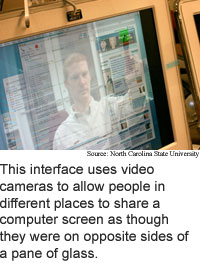
Interface blends screen and
video
By
Kimberly Patch,
Technology Research NewsEmail, telephone calls and even conferencing software all fall far short of direct collaboration.
Researchers from the University of North Carolina at Chapel Hill have devised a videoconferencing system that comes a step closer. Facetop superimposes transparent images of a computer's desktop over video images of the user to allow the user to look at the video and desktop at the same time.
The video shows a ghostly mirror image of the user so that when he points, his video reflection appears to touch objects on the screen. The system tracks fingertip position in the video to allow the user to control the mouse pointer.
As it turns out, the human visual/brain system "seems to be quite good at paying attention to one and ignoring the other, depending on whether you want to see the user or the desktop information," said David Stotts, an associate professor of computer science at the University of North Carolina at Chapel Hill.
The system can be used for remote teaching, PowerPoint presentations, and as a basic PC interface with fingertip and pointing mouse control, said Stotts.
A two-user version combines the video streams of remote users and presents the images side-by-side. This allows each person to control the desktop, watch the other person control the desktop, and see the other's face. A third version of the system allows users to hyperlink objects in video image.
The system is especially appropriate for remote collaborations where two people need to discuss some sort of document or artifact that can be represented on a PC, including architectural and medical images, software code, and Web documents, said Stotts. "Internet-based collaborations have always been hampered by a lack of sense of presence, a lack of being able to know what your partners are doing," he said. "Body language is critical to understanding."
The system is easier to use than current videoconferencing systems that put video and content in separate windows or screens because these require the user to shift attention back and forth, said Stotts.
The idea came when one of the researchers was simultaneously running a video application that had come with a camera and a PC whose display was projected on the wall when a colleague came in to his office. "I happened to have a small video application running... had pointed the camera back at myself and... set it to reverse the horizontal direction like a mirror," said Stotts.
"When Jason [Smith] and I were talking about something that was on my PC desktop projected onto the wall... I reached my hand into the air so that... my image on the screen also was pointing to the item on the desktop," said Stotts. "Jason saw that and said 'what if we made that full-screen', and we were off," he said. "We added the idea of transparency so that the entire desktop would show through."
The system is relatively inexpensive to implement, said Stotts. "All we need is a $100 FireWire camera, a Macintosh and the Internet," he said. The system's software controls the transparency effect and the fingertip tracking.
The technical challenges were getting the transparency to work so that user applications did not shut it off, carrying out finger tracking quickly enough to match the 30-frames-a-second video, and sending a video signal over the Internet, said Stotts.
The system contains a setting that turns the transparent video on and off when the user raises a hand into the camera view. "This is nice for PowerPoint presentations," said Stotts. In one experiment, the researchers were able to allow two users who have hearing disabilities to have a video-based signing conversation using the software, he said.
The user can set the level of transparency, said Stotts. "Some users like to see a lot of face mixed in with their [desk]top, others like a faint video image."
The third version of the system, dubbed FaceSpace, allows users to create hyperlinks for objects in the video image. A second camera is aimed at a whiteboard and this image is mixed into the FaceTop composite. Words, symbols and lines drawn on the whiteboard appear to float over objects in the user video image. The system lets users create hyperlink hotspots for markings on the whiteboard or objects in the user video.
A Macintosh version of FaceTop could be implemented within a few months, and a PC version within two years, according to Stotts. The PC version would have to wait for the next major version of the Windows operating system, which will have the needed technical infrastructure, he said.
The researchers are working on a multi-person version of the system, are performing studies of how well the system works for collaborative programming, and are adapting a version that can be used with wide, very high quality displays.
Stotts's research colleagues were Jason McC. Smith and Karl Gyllstrom. The research was funded by the U.S. Environmental Protection Agency (EPA).
Timeline: > 2 years
Funding: Government
TRN Categories: Human-Computer Interaction
Story Type: News
Related Elements: Technical papers, "Synchronous Pair Collaborations Support with the Transparent Video Facetop," posted at http://rockfish-cs.cs.unc.edu/pubs/TR04-008.pdf; "Distributed Collaborations in Facetop" posted at
Advertisements:
June 30/July 7, 2004
Page One
Software fuse shorts bugs
Holograms enable pocket projectors
Memory cards make connections
Interface blends screen and video
Briefs:
Paper promises better e-paper
Birds-eye view helps guide public
Nanotubes boost neuron growth
Chip protects single atoms
Mega video enables virtual window
Method tests molecular devices

News:
Research News Roundup
Research Watch blog
Features:
View from the High Ground Q&A
How It Works
RSS Feeds:
News
Ad links:
Buy an ad link
| Advertisements:
|
 |
Ad links: Clear History
Buy an ad link
|
TRN
Newswire and Headline Feeds for Web sites
|
© Copyright Technology Research News, LLC 2000-2006. All rights reserved.